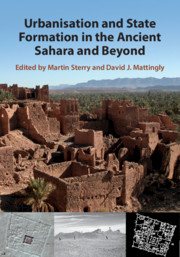Book contents
- Urbanisation and State Formation in the Ancient Sahara and Beyond
- The Trans-saharan Archaeology Series
- Urbanisation and State Formation in the Ancient Sahara and Beyond
- Copyright page
- Contents
- Figures
- Tables
- Contributors
- Preface
- Part I Introduction
- Part II Oasis Origins in the Sahara: A Region-by-Region Survey
- Part III Neighbours and Comparanda
- 9 Early States and Urban Forms in the Middle Nile
- 10 Mediterranean Urbanisation in North Africa
- 11 Numidian State Formation in the Tunisian High Tell
- 12 The Origins of Urbanisation and Structured Political Power in Morocco
- 13 Architecture and Settlement Growth on the Southern Edge of the Sahara
- 14 Long-Distance Exchange and Urban Trajectories in the First Millennium AD
- 15 First Millennia BC/AD Fortified Settlements at Lake Chad
- 16 At the Dawn of Sijilmasa
- 17 The Early Islamic Trans-Saharan Market Towns of West Africa
- 18 Urbanisation, Inequality and Political Authority in the Sahara
- Part IV Concluding Discussion
- Index
- References
12 - The Origins of Urbanisation and Structured Political Power in Morocco
Indigenous Phenomenon or Foreign Colonisation?
from Part III - Neighbours and Comparanda
Published online by Cambridge University Press: 23 March 2020
- Urbanisation and State Formation in the Ancient Sahara and Beyond
- The Trans-saharan Archaeology Series
- Urbanisation and State Formation in the Ancient Sahara and Beyond
- Copyright page
- Contents
- Figures
- Tables
- Contributors
- Preface
- Part I Introduction
- Part II Oasis Origins in the Sahara: A Region-by-Region Survey
- Part III Neighbours and Comparanda
- 9 Early States and Urban Forms in the Middle Nile
- 10 Mediterranean Urbanisation in North Africa
- 11 Numidian State Formation in the Tunisian High Tell
- 12 The Origins of Urbanisation and Structured Political Power in Morocco
- 13 Architecture and Settlement Growth on the Southern Edge of the Sahara
- 14 Long-Distance Exchange and Urban Trajectories in the First Millennium AD
- 15 First Millennia BC/AD Fortified Settlements at Lake Chad
- 16 At the Dawn of Sijilmasa
- 17 The Early Islamic Trans-Saharan Market Towns of West Africa
- 18 Urbanisation, Inequality and Political Authority in the Sahara
- Part IV Concluding Discussion
- Index
- References
Summary
This chapter reviews the evidence for the emergence of urbanisation in Morocco and evaluates the contributions of Phoenician settlers and of local communities to this process. In line with the new evidence from Tunisia, the previously emphatic emphasis on the role of outsiders in introducing urbanism and sparking the initial steps towards state formation now seems less convincing, with a much more significant role for local actors.
After first reviewing the ancient source evidence and the history of archaeological research, I shall present the latest archaeological findings based on my personal experience of a number of key settlements, as well as some impressive funerary monuments that illustrate the emergence of hierarchy within early Berber (Imazighen) society (Fig. 12.1)
- Type
- Chapter
- Information
- Publisher: Cambridge University PressPrint publication year: 2020
References
- 3
- Cited by

